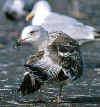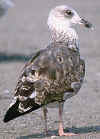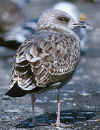second calendar year: August
Last update of this page: 27-09-05 20:42
In Lesser Black-backed Gulls, nearly all feathers are being replaced by August. There may be great differences, both between individual and in time: between the beginning and the end of the month. Many birds change from a grabby immature into a fresh bird with adult-like upper-parts and under-parts. From head to toe you can see the following changes.
- The bill becomes paler. Variation in bill colour is very obvious now. All-black bills (still present in 20%) show pink bases while some birds (advanced) may show a pink-yellow bill with only a small sub-terminal band. The average birds show a pink bill with a dark distal half.
- The iris turns paler brown or whitish, the advanced birds already show a yellowish white iris.
- The head varies from all-white without any speckling or streaking to 'dirty' and heavily streaked on a grey background.
- The under-parts moult into white feathers, with dark streaks on the flank and at the sides of the breast. Quite some birds show all-white worn under-parts by late August, with only some streaking on the flanks.
- The mantle and scapulars consist of old worn 2nd or 3rd generation feathers, being plain with a darker shaft-streak and sub-terminal band, and fresh 3rd or 4th generation feathers, being adult-like (though slightly paler than pure adult-grey) and often with a darker shaft-streak or central wedge.
- At the end of August, the majority of 2cy LBBG shows many 3rd generation mantle-feathers, creating a grey triangle on the back.
- The differences in the amount of adult-grey feathers on mantle/scapulars are obvious: some 2cy just have a few grey feathers on the mantle while others have moulted all mantle and scapulars into adult-like 3rd or 4th generation feathers.
- Most 2cy LBBGs still moult their mantle and scapulars at the end of August (well into September), so the area of grey on the upper-parts may still grow creating the grey saddle, as often seen in 3cy birds returning in spring.
- Tertials on a 2cy LBBG in August can exist of old juvenile as well as fresher 2nd generation feathers or (for advanced birds) newly moulted 3rd generation feathers. The juvenile tertials are very worn pale brown, while 2nd generation feathers are all black with a broad white tip (normally with a thumb-print pattern or vermiculation at the sides). New 3rd generation tertials are adult-like grey but may lack the obvious white tip. By August, many birds miss at least some tertials, often the upper tertials. When present, the upper tertials are normally the most recently moulted ones.
- The wing-coverts are in active moult, so gaps in the covert bars are very common. Normally, moult starts with the median coverts. While moulting these medians, birds start to shed the greaters (and may shed the lessers as well). The inner median coverts are normally moulted from the body to the outer-wing (up to #5 app.), while the outer medians grow towards the body. Normally the meet at the 7th or 8th median covert, counted from the body. The same applies to the greater coverts, where moult normally starts with the inner coverts. Wing covert moult ends with the outer lesser coverts. Often, these feathers may be a clue for the age of a bird.
- A common state of moult on a 2cy LBBG by
mid-August is:
new inner medians (2nd generation), a few new inner greaters (2nd generation), missing outer and central greaters, missing at least the inner half of the lessers and retained outer lessers. The 2nd generation greater coverts are normally blackish with no or faint barring. Second generation medians and lessers contrast with 1st generation feathers; they are black centred with a whitish fringe or show barring or anchor patterns. - The primaries are moulted outwards and at the end of August all present birds (n = 130) showed at least a fully grown p6. The average moult score by the end of the month is 40, with p7 fully grown, p8 half-way and p9 just visible. But some birds scored 35, while some advanced individuals showed scores of 50. Compared to the old juvenile primaries, new primaries are darker (jet black) and have a rounded top. The inner primaries are paler than the outers, often p1 and p2 with a darker shaft on a brownish background.
- The secondaries are shed inwards, from the moment p5 is half way to fully grown, often creating large gaps from p1 inwards. They are shed simultaneously (a few, about 5, remain juvenile, and are visible as a block at approximately S5-10 and S16-17). Secondaries grow fast; birds with primary moult score 40 already have at least 5 new secondaries, which are black centred.
- The under-wing becomes paler, as juvenile under-wing coverts are replaced by white or black-and-white (contrasting) 2nd generation feathers.
- The tail is 2nd generation in many birds, still in active moult on some, but fully grown in many. The new feathers are all-black or white with a broad irregular black band. In many birds the 2nd generation tail shows more black than on the juvenile. By November, some 2cy LBBGs show predominantly white tail-feathers and probably some 2cy moulting the tail-feathers in July are replacing 2nd generation feathers for 3rd generation rectrices.
- Structurally, LBBGs show much individual variation. One bird can easily be as large and robust as a Greater Black-backed gull, while another (like female intermedius) is only slightly larger than Common Gull (L.canus), gently built with an attenuated rear.
- The more constant colour of the legs is flesh-coloured to pink; only a very few have a hint of yellow.
- Those birds with advanced mantle and scapulars may look like 3cy birds as they return in the Netherlands by May next year.
Tables:
The tables below show primary scores of 2cy
LBBG in August. In the Netherlands, we have seen colour-ringed and
metal-ringed birds from British, Belgian, Dutch, German and Scandinavian
projects, thus from graellsii, intermedius and Dutch
intergrade populations. We therefore do not specify data to taxa
level.
2cy LBBG were identified on primary pattern ad upper-part coloration.
Primaries are scored fully-grown when a primary exceeds the previous
feather in the folded wing. Note that this also includes feathers which
would be scored 'just not fully grown' (score 4) in other researches. We
choose this score since it proved to be very difficult to establish the presence
of waxy sheath on the feather-base in field researches.
When judging the old primaries, be aware of the dark print on outer
primaries, created by the shed, previous feather. Such prints may contrast
strongly with the bleached primary tips.
|
2cy LBBG Maasvlakte - the Netherlands, Aug 14 2003 |
|||||||
| new P | p5 | p6 | p7 | p8 | p9 | p10 | n: |
| P8 | 1 | - | - | - | - | - | 1 |
| P9 | 1 | 12 | - | - | - | - | 13 |
| P10 | - | - | 7 | - | - | - | 7 |
| no old P | - | - | 9 | 2 | - | - | 11 |
| n: | 2 | 12 | 16 | 2 | - | - | 32 |
|
notes: |
|
||||||
|
2cy LBBG Westkapelle, the Netherlands, Aug 15 2003 |
|||||||
| new P | p5 | p6 | p7 | p8 | p9 | p10 | n: |
| P8 | 2 | 1 | - | - | - | - | 3 |
| P9 | - | 12 | - | - | - | - | 12 |
| P10 | - | - | 22 | - | - | - | 22 |
| no old P | - | - | 3 | 3 | - | - | 6 |
| n: | 2 | 13 | 25 | 3 | - | - | 43 |
|
notes: |
|
||||||
|
2cy LBBG Maasvlakte - the Netherlands, Aug 22 2002 |
|||||||
| new P | P5 | P6 | P7 | P8 | P9 | P10 | n: |
| P8 old | 2 | 2 | - | - | - | - | 4 |
| P9 old | - | 5 | 1 | - | - | - | 6 |
| P10 old | - | - | 25 | 2 | - | - | 27 |
| no old | - | - | 12 | 16 | 1 | - | 29 |
| n: | 2 | 7 | 38 | 18 | 1 | - | 66 |
|
notes: |
|
||||||
|
2cy LBBG Maasvlakte - the Netherlands, Sept 28 2001 |
|||||||
| new P | P5 | P6 | P7 | P8 | P9 | P10 | n: |
| . | - | - | 9 | 26 | 61 | 9 | 105 |
|
notes: |
|||||||
2cy LBBG: Dutch intergrade
 LBBG
L-x9892
2cy, August 15 2003, Westkapelle, the Netherlands.
LBBG
L-x9892
2cy, August 15 2003, Westkapelle, the Netherlands. LBBG
L-901x95
2cy, August 29 2005, Westkapelle, the Netherlands.
LBBG
L-901x95
2cy, August 29 2005, Westkapelle, the Netherlands. LBBG
A12E
2cy, August 14 2003, Naaktstrand, Maasvlakte, the Netherlands.
LBBG
A12E
2cy, August 14 2003, Naaktstrand, Maasvlakte, the Netherlands. LBBG
A82E
2cy, August 14 2003, Naaktstrand, Maasvlakte, the Netherlands.
LBBG
A82E
2cy, August 14 2003, Naaktstrand, Maasvlakte, the Netherlands. 2cy
LBBG C95 E,
August 14 2004, Amsterdam, the Netherlands. A bird ringed left red C95,
right yellow E.
2cy
LBBG C95 E,
August 14 2004, Amsterdam, the Netherlands. A bird ringed left red C95,
right yellow E. LBBG IE
2cy, August 29 2003, IJmuiden, the Netherlands.
LBBG IE
2cy, August 29 2003, IJmuiden, the Netherlands.2cy LBBG: intermedius
 LBBG J93T
2cy, August 21 2003, IJmuiden, the Netherlands.
LBBG J93T
2cy, August 21 2003, IJmuiden, the Netherlands. LBBGJT74
2cy, August 21 2002, Cambridge, U.K. (52.14N 00.09E). Ringed in
Norway July 03 2001.
LBBGJT74
2cy, August 21 2002, Cambridge, U.K. (52.14N 00.09E). Ringed in
Norway July 03 2001.2cy LBBG: unringed birds
 photo
7837: 2cy LBBG, August 15 2003, Westkapelle, the Netherlands.
photo
7837: 2cy LBBG, August 15 2003, Westkapelle, the Netherlands. photo
7842: 2cy LBBG, August 15 2003, Westkapelle, the Netherlands.
photo
7842: 2cy LBBG, August 15 2003, Westkapelle, the Netherlands. photo
7844: 2cy LBBG, August 15 2003, Westkapelle, the Netherlands.
photo
7844: 2cy LBBG, August 15 2003, Westkapelle, the Netherlands. photo
7874: 2cy LBBG, August 15 2003, Westkapelle, the Netherlands.
photo
7874: 2cy LBBG, August 15 2003, Westkapelle, the Netherlands. photo
7885: 2cy LBBG, August 15 2003, Westkapelle, the Netherlands.
photo
7885: 2cy LBBG, August 15 2003, Westkapelle, the Netherlands. photo
7943: 2cy LBBG, August 15 2003, Westkapelle, the Netherlands.
photo
7943: 2cy LBBG, August 15 2003, Westkapelle, the Netherlands. photo
7969: 2cy LBBG, August 15 2003, Westkapelle, the Netherlands.
photo
7969: 2cy LBBG, August 15 2003, Westkapelle, the Netherlands. photo
7983: 2cy LBBG, August 15 2003, Westkapelle, the Netherlands.
photo
7983: 2cy LBBG, August 15 2003, Westkapelle, the Netherlands. photo
7994: 2cy LBBG, August 15 2003, Westkapelle, the Netherlands.
photo
7994: 2cy LBBG, August 15 2003, Westkapelle, the Netherlands. Photo
1: LBBG
2cy, August 24 2000, Le Portel, France.
Photo
1: LBBG
2cy, August 24 2000, Le Portel, France.  Photo
2: LBBG
2cy, August 24 2000, Le Portel, France. Note new rectrices.
Photo
2: LBBG
2cy, August 24 2000, Le Portel, France. Note new rectrices. Photo
3: LBBG
2cy, August 24 2000, Le Portel, France. Typical bird.
Photo
3: LBBG
2cy, August 24 2000, Le Portel, France. Typical bird. Photo
4: LBBG
2cy, August 24 2000, Le Portel, France.
Photo
4: LBBG
2cy, August 24 2000, Le Portel, France. Photo
5: LBBG
2cy, August 23 2000, Le Portel, France. Showing moult score. Note the
secondaries.
Photo
5: LBBG
2cy, August 23 2000, Le Portel, France. Showing moult score. Note the
secondaries.  Photo
6: LBBG
2cy, August 23 2000, Le Portel, France. Another
typical graellsii.
Photo
6: LBBG
2cy, August 23 2000, Le Portel, France. Another
typical graellsii. Photo
7: LBBG
2cy, August 25 2000, Le Portel, France.
Photo
7: LBBG
2cy, August 25 2000, Le Portel, France. Photo
8: LBBG
2cy, August 25 2000, Le Portel, France.
Photo
8: LBBG
2cy, August 25 2000, Le Portel, France. Photo
9: LBBG
2cy, August 23 2000, Le Portel, France. Ringed
in Belgium. Advanced bill-colour.
Photo
9: LBBG
2cy, August 23 2000, Le Portel, France. Ringed
in Belgium. Advanced bill-colour. Photo
10: LBBG
2cy, August 24 2000, Le Portel, France.
Photo
10: LBBG
2cy, August 24 2000, Le Portel, France.  Photo
11: LBBG
2cy, August 24 2000, Le Portel, France. Ringed in Belgium.
Photo
11: LBBG
2cy, August 24 2000, Le Portel, France. Ringed in Belgium. Photo
13: LBBG
2cy, August 25 2000.
Photo
13: LBBG
2cy, August 25 2000. Photo
14: LBBG
2cy, August 25 2000, Le Portel, France.
Photo
14: LBBG
2cy, August 25 2000, Le Portel, France.